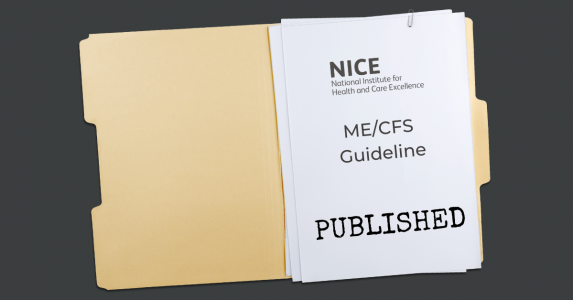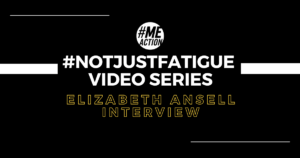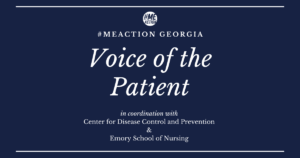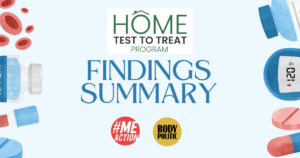The National Institute for Health and Care Excellence (NICE) has now published its ME/CFS guideline and we are delighted that they have finally listened to the ME community in several key areas.
NICE delayed publication of this guideline in August after concerns were raised by a few Royal Colleges. Instead, they held a roundtable event, chaired by a former President of the Royal College and Physicians, inviting stakeholders of the guideline to discuss these concerns. Janet Sylvester, who attended on behalf of #MEAction UK, said “This was a positive meeting. The discussion put to rest concerns, ensuring this guideline can be effectively implemented.”
Overall, #MEAction UK is pleased that the final guideline is a significant improvement on the 2007 CFS/ME guideline. We recognise the enormous amount of work done by the NICE guideline committee over the past three years and thank them for their hard work and commitment.
Adam Lowe, patient representative on the NICE guideline committee, explained how decisions had been reached: “What surprised me was the amount of agreement in the room. The guideline was produced by consensus and was signed off by the whole committee. I feel that’s a big achievement and proof that we struck the right balance.
“It was an honour to be part of such a thorough, transparent and professional process. Discussions weren’t always easy, but they were always handled with mutual respect and an earnest passion for helping the people affected by ME.”
The recognition that Graded Exercise Therapy (GET) causes significant harm and should not be offered to people with ME is a huge step forward and we hope that this will lead to the end of this harmful treatment. The guideline not only defines the treatment that people with ME receive in England and Wales, but also has an impact across the world. #MEAction Scotland is campaigning to ensure that the relevant sections of the guideline are adopted in Scotland.
Adam added, “Some people will read the removal of GET as a net loss for clinics. But that’s just not true. Time and time again, we heard from clinics that they felt hamstrung by the old guidelines, which only allowed them to offer two treatments — CBT and GET, perhaps with activity management as a neutral third option. If they tried to do anything else, they often wouldn’t receive funding. Patients who didn’t want these treatments were discharged without any further help.
“Now clinics can push for a broader range of skills in their team, such as dietitians, consultant physicians, specialist nurses, and experts in orthostatic intolerance, sleep and pain. With patients having regular review and monitoring, clinicians will have an expanded role. Clinics should be better resourced and more in tune with what patients want, which is a win for everybody.”
Other key recommendations in the guideline are:
- The acknowledgement of the prejudice and disbelief that people with ME have suffered and the impact that being stigmatised by people who do not understand the illness could have on how people are treated by health and social care services
- Separate recommendations for those with severe/very severe ME and children and young people will be critical in ensuring that these groups of patient start to receive the support they need
- The opportunity to access care and support through methods such as phone calls, online consultations or home visits will make a real difference to patients struggling with in-person appointments
- The recommendation to supply aids and adaptations without delay will be a major benefit to those who need access to this type of support
- Acknowledgement that CBT is not curative and should only be used to help manage living with a chronic illness is important
Issues that we highlighted in our response to the draft guideline have been addressed to varying degrees. In some cases, such as the wording on advice for people with suspected ME/CFS, NICE has accepted our suggested wording. For other issues, it has made amendments in response to our comments that are an improvement on the draft. For example, on multidisciplinary care, the final guideline includes a specific recommendation on the need for expertise in medical assessment and diagnosis, and prescriptions management, a definite improvement on the draft where no mention was made of the need for a physician in the multidisciplinary team.
Concerns remain around how the section on incorporating physical activity will be implemented in practice. While some physiotherapists have a clear understanding of ME and can provide helpful support, others will require significant training and education to ensure harmful practices do indeed stop.
We also have concerns about the lack of detail in the section on ‘Training for health and social care professionals’. Any change in approach to managing ME hinges on both the content of new training and the ability of those undertaking it to accept and alter their views accordingly. Despite our call, along with many other stakeholders, for this section to be expanded from the draft it has been significantly cut back and the recommendation that training should be developed with input from people with ME/CFS has been removed.
We are also disappointed that the section on research has not been significantly expanded from the draft and does not include any mention of research into the causes of ME, as a clearer understanding of the pathophysiology will significantly help in the search for treatments and eventually a cure. We do however consider a core outcome set key to ensuring future clinical trials are based on sound science, and appreciate the inclusion of this research recommendation.
A huge thank you and next steps
In the run up to and throughout the guideline development, #MEAction UK and #MEAction Scotland volunteers have worked to make sure that the views of our community have been represented – both in the formal consultations and through additional lobbying. A huge thank you to all the volunteers who have contributed to this, and to all those who have written to us, taken part in community meetings or campaigns, or commented on social media! It’s been an incredible collective effort.
What next?
We’ve got more campaigns, opportunities to understand the guideline in more detail and a chance to thank the committee members who fought for these positive changes all lined up, so keep an eye out in the coming days and weeks.
The best way to do this is to follow us on social media, or subscribe to receive emails.







5 thoughts on “Final NICE ME/CFS guideline published – find out the big news!”
The date of this article needs to be updated…
This is way beyond anything I hoped. I’m absolutely over the moon and so incredibly grateful to every single person who contributed to the campaign and research that led to this point. 😁😁😁👏👏👏💛💛💛💛💛💛💛💛💛🥳🥳🥳🚀
I have to say that you are talking up this new guideline that basically takes us back to the situation in 2007 before the era of GET/CBT.
We have a Tory government that is hell bent of privatising the entire NHS which will only make the standard of care worse while huge amounts of money being swallowed up by private companies. Decisions about local NHS services are made by unelected CCG’s that are distant and remote from ordinary people. It is against this background you come out with the hopium that somehow services for pwME are going to improve.
I got much worse under the care of Leeds ME clinic at Seacroft hospital. The clinics are full of people who do not understand ME.
Where is the commitment to train doctors and other health professionals so that they are up to date with the latest research on ME?
Where is the commitment to massivey increase the amount of money going into biomedical research into ME?
How will this new guideline improve the experience of pwME claiming disability benefits? In a FOI request that I did it revealed that nearly 50% of pwME were having their claims for ESA turned down.
Congratulations! Ron and I are so pleased.
Janet Dafoe
I would like to say thank you for this victory in amending the guideline although, I do also agree with the key points raised by Dr. Murphy; the victory for me lies in the dimunition of GET and CBT as a treatment. They are self-management tools at best and whilst science should support the development of treatment, the rigorous and over zealous adherence to evidence based practice and NICE guidance can in my opinion, be detrimental to some patients.
I am forever grateful to the physiotherapists and M E service staff who helped me in my early days 8 years ago, but the key harms I eventually had to come to terms with, were the”pushing through” mentality it created within me, which was incredibly self-defeating in the short and long term, pushing my stress levels unconsciously beyond my limits and any chances of stabilising to a modicum of some improved quality of life out of scope.
Fortuneately, a skilled counsellor was able to help me destroy the added harm I waa doing to myself because of this harmful approach. Skilled coaching wan’t available. Resource constraints in reality meant that after you has been equipped with all the knowledge, you were basically on your own.
Additionally, given that precious energy is also diminished by mental activity as well as physical, I have never experienced so much mental activity and form filling or paperwork exercises in managIng an illness (and I previously worked in high level administration).
That is not to say that some form of exercise is essential to maintaining health and functioning and that CBT might also prove helpful in the management of long term illness for some patients who can cooe with it, but it needs to much better defined, trained and implemented in the context of patients with M.E if it is ever to be offered as a potential support option.
The cruelist part of this disease apart from the sheer day to day suffering and difficulties a patient experiences, it is the ‘not being believed’ or that it is self-inflicted and therefore, the onus is on you to get yourself better. I have met many kind and compassionate people and have been very fortunate in that respect, but there are many who aren’t.
An holistic approach (across all aspects of a patient’s life) towards supporting patients with M.E feels like it has a long way to go and is inconsistent depending on where you live. Against the background of the pandemic, it will be interesting to see how the ‘Long Covid syndrome effect’ may develop research, learning and strategies for treatment
Comments are closed.